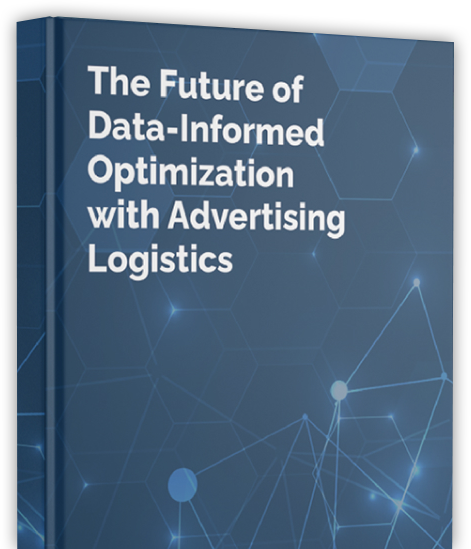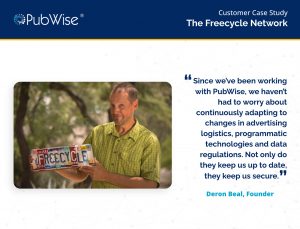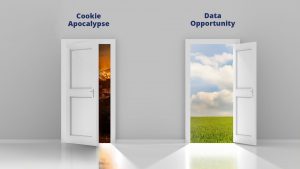Description
It’s not about festivities or politics, it’s about who owns the data. What does it mean to be ‘1st Party’ in the world of programmatic advertising? Join Tony and Stephen in our first Episode as we begin a deep dive into the future of Digital Marketing and how AI will play its part.
Transcript
Tony Winders: Hello everyone and welcome to On The Spot. My name is Tony Winders, and I’m here today with Stephen Johnston, founder and CTO of PubWise. Today I’ll be putting Stephen on the spot about the changing role of how data is used for consumer targeting and digital advertising. Stephen, welcome, and thanks as always for taking the time. So how should we be thinking about first-party vs. third-party data in the context of programmatic advertising?
Stephen Johnston: Yeah, thanks for having me. So first-party, you break this down, we’ve got first-party, second-party, third-party, and it’s really a matter of who owns that data? Who collects it? Who curates it? Who gets permission about where it goes, and how it’s used? In the context of programmatic advertising, we’re really talking about publisher-sourced data. It’s inherently permission-based, it’s some activity that a person’s performing on a site, some activities they’re doing with a publisher. It allows a publisher in this first-party context to retain the user relationship with the publisher, instead of giving them up, which is, from a publisher’s perspective, the sort of primary, you know, negative of what is currently more common third-party data, where you have a user, you get some designation, like in a cookie ID from a third-party, they get marked, and wherever that person goes that that third-party continues to leverage the value of that user. And so you know, that value is now in some ways leaked. And that’s just part of the, it’s not necessarily a bad thing, it’s just, it’s just part of the bargain that’s made around data currently. So when we move to first-party, it’s related to contextual, but not the same. It’s complimentary. It’s post cookie, post regulation safe, for the most part, that’s its own kind of, you know, deep well of conversation. But you’re located closest to the source of permission with first-party data. So the place at which the user says “yes, you can use my data” is the same place that the data is at. And that provides a lot of value. And it provides a lot of opportunity. So you’re collecting that data on your website and your app, user registration, based on user activity, in your CRM. And you know, all these things about a user. And you have it first-party, so the publisher has control over it, the publisher can protect its value, the publisher can choose who to share it with. That brings up a lot of opportunities in the space. And you can think of these as challenges, but they’re opportunities. The opportunity for the publisher is that everybody’s got to learn how to transact on first-party data more than they have been previously, you’ve got to understand who in the marketplace and who in the ecosystem they can transact with. There’s a lot of change, there’s challenges around keeping up. And the hardest part of all of this end data is the pass off from entity to entity in the value chain. So we talked earlier about third-party and it’s like, every instance of that data, every instance of that user relationship immediately becomes one or two steps more removed, and a lot of the current setups. So connecting buyers and sellers seamlessly is really key in order to obtain that value. First-party data enables that. Why do we care? Well, you know, the sort of high fructose corn syrup of all this is easy third-party data, regulations coming around, the cookie apocalypse, you know, whenever that takes place, it’s going to change this. And so publishers need to diversify how they’re servicing that data, how they’re marketing it, how they’re presenting it to buyers.
And there’s a race currently to sort of implement, facilitate or, you know, get involved in how those transactions are being made. So, we’ve got a bunch of standards coming around, like FLoC, data levels and seller-defined audiences from the IAB. And transitionally, tactics to look at what is the tail of the cookie and how does it still relate in this? And so for some period of time cookies will be out there, whether it’s on 30%, or 60% of transactions and that sort of thing. How do they relate? How do they let us wean ourselves off that high fructose corn syrup? They have a role. And ultimately, like a lot of things, it comes down to taxonomy. And so all this eventually rolls up to what do we call a thing? And so when we talk about data, typically, what you’re really buying is the designation of a user and their interests in relation to some product that an advertiser wants to sell. And there’s a whole bunch of complexity about how that’s done and attribution. But it comes down to naming it and we, we’ve heard of some of these things, auto intender, you know, has a child, you know, or a child soon. And these kinds of things in the market indicate different buying behavior or different interests in specific products that may align to an advertising campaign. But if we don’t call things the same thing, we lose, we lose the attachment. And so in the third-party space, you were going to a third-party, and you sort of aggregated to them and what they called it, they worked out with buyers to use the same name. So a lot of the opportunity and the challenge for publishers right now is what do we call it? It’s like, if you have chickens to sell what you call them, egg laying avians. You know, any, you might just miss all the people that are searching for chickens, it’s almost like SEO. And so the, you know, we talk about a first-party platform, it’s, it’s a platform that takes into account, all of that laundry list of things that we just went through, it’s kind of in its DNA. And when you look at each connection in the current advertising ecosystem, it loses value, or it introduces legislation and regulation issues. When you go into the entity you lose value along the way, you sort of leak that value. The opportunity in this transition with publishers is to retain as much of that first-party customer relationship as they can and using a first-party end-to-end system reduces the number of connections where that value leaks, it allows them to retain control of the first-party data, and then maximize the value in the market, so long as you can still agree on taxonomy. So a system like ours is a system that allows you to have that third-party advantage of common taxonomy, technical approach, while retaining a first-party technical or you can almost think of it as a regulatory relationship with the data.
Tony Winders: So how does PubWise account for that for its publishers? So do you represent that data to the advertisers? What’s that relationship like between you and the publishers and also PubWise and its advertisers? Because they have first-party data too that they may bring to the table, but it seems like a big spaghetti bowl of data that should keep you employed for years to come. What’s PubWise’s role as the first-party programmatic platform in helping the publishers get that value? Is it because your code is on their pages in the header-bidding process, you have access to it?
Stephen Johnston: Largely, it’s about that electrical connection and keeping that electrical connection clean. And that electrical connection is how, how closely do you connect sellers to buyers? With you know, we’re talking about taxonomy and what you call something, the risk is that everything becomes a game of telephone. And so, you’re offering one thing, but the market is hearing another or just not hearing you at all, because something is missing in this technical electrical connection. And so that’s kind of fundamentally one role. But the other thing is that in areas where there’s disagreement or multiple ways to accomplish something, how do you measure the relative value? You know what I said earlier about chickens and egg laying avians, it’s nice for everybody to call it chickens, but what if egg laying avians are actually worth more? You know, we encounter things like that. And so it isn’t just a matter of setting a static way of seeing the world, it’s a matter of being technically nimble, it’s a matter of measuring the things you do and letting you make changes and see how the market responds on the buy side. So our role is to make sure that the publisher can focus on attracting audience that has value, doing the things as a publisher that they need to get the information out of that user to assign the value, and then to provide the connection for them to sell it out to the advertiser. And that value offering has just flipped for the advertiser. When the advertiser looks back towards the publisher, what they’re seeing is, well-defined data, it’s got accurate labeling, it hasn’t gone through hundred hands and sort of gotten chopped up, or that game of telephone. The nice thing about this is that there’s a twinning here, when you are end-to-end and you are first-party, the value is essentially just the other side of the coin, you know, in terms of both of the players, seller and buyer. They both see value in the same things, their interests are aligned, what they want out of the systems are aligned. And that’s a real opportunity.
Tony Winders: Obviously, the industry is moving faster than ever, regulation is changing and PubWise is innovating in this area. What’s the one thing that you would have publishers or advertisers know about a first-party programmatic platform? Or what’s the kind of the big takeaway you would have them remember out of this conversation?
Stephen Johnston: People have already largely started some efforts around what they can sort of wrap their arms around, which is, what do we know about our users? How do we define it? And how do we see them internally? And I think, I know, publishers need a partner that’s going to help them define how does the market sees that same inventory? And then how do we present it in a way that retains its value? And for the advertisers, I think that they are going to go through a period where they put some bigger, some bets more spread around. And a platform like ours that’s actively monitoring performance, not just assigning things, setting them and forgetting them, is going to more quickly define and I would say discover the winning and losing solutions as we see these things evolve. So our philosophy isn’t to pick one single approach, bet on it, and then just ride it until it lives or dies, but is to build a system that’s capable of doing multiple approaches that are coming out as standards and really run the race between them to measure and identify which ones are performing the best. And we’re going to find that isn’t always the same thing for one publisher and one advertiser. And so, there’s a journey, and all of these guys, the takeaway is, you need a technical partner that can make all that happen so that you come out the other side winning this shakeup.
Tony Winders: Well, I could chat you up for another 30 minutes on this topic, but I figure we should leave people wanting more. And we’ll have lots more conversations like this one. And I’ve got other topics I can’t wait to ask you about. But right now, I’d just like to thank you for your brilliant, technical mind and your time and thank those listening for being here on the spot with Stephen Johnston, the CTO and Founder of PubWise, and we’ll look forward to putting you on the spot again real soon, Stephen. Thank you. Appreciate it.





